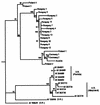Phylogenetic analysis of acute bee paralysis virus strains
- PMID: 12450876
- PMCID: PMC134446
- DOI: 10.1128/AEM.68.12.6446-6450.2002
Phylogenetic analysis of acute bee paralysis virus strains
Abstract
Reverse transcription-PCR assays have been established for a quick, sensitive, and specific diagnosis of acute bee paralysis virus (ABPV), a common virus of the honeybee (Apis mellifera), directly from clinical samples. A 3,071-nucleotide fragment of the ABPV genome, which includes the entire capsid polyprotein gene, was amplified from Austrian, German, Polish, and Hungarian ABPV samples and sequenced, and the sequences were compared. The alignment of a smaller fragment with ABPV sequences from the United States and the United Kingdom revealed nucleotide identity rates between 89 and 96%, respectively. Phylogenetic trees which display the molecular relationship between the viruses of different geographic origin were constructed.
Figures


Similar articles
-
Analysis of the complete genome sequence of acute bee paralysis virus shows that it belongs to the novel group of insect-infecting RNA viruses.Virology. 2000 Nov 25;277(2):457-63. doi: 10.1006/viro.2000.0616. Virology. 2000. PMID: 11080493
-
Complete nucleotide sequence of Kashmir bee virus and comparison with acute bee paralysis virus.J Gen Virol. 2004 Aug;85(Pt 8):2263-2270. doi: 10.1099/vir.0.79990-0. J Gen Virol. 2004. PMID: 15269367
-
Detection of acute bee paralysis virus and black queen cell virus from honeybees by reverse transcriptase pcr.Appl Environ Microbiol. 2001 May;67(5):2384-7. doi: 10.1128/AEM.67.5.2384-2387.2001. Appl Environ Microbiol. 2001. PMID: 11319129 Free PMC article.
-
The Acute bee paralysis virus-Kashmir bee virus-Israeli acute paralysis virus complex.J Invertebr Pathol. 2010 Jan;103 Suppl 1:S30-47. doi: 10.1016/j.jip.2009.06.014. Epub 2009 Nov 11. J Invertebr Pathol. 2010. PMID: 19909972 Review.
-
Impact of managed honey bee viruses on wild bees.Curr Opin Virol. 2016 Aug;19:16-22. doi: 10.1016/j.coviro.2016.06.006. Epub 2016 Jun 25. Curr Opin Virol. 2016. PMID: 27351468 Review.
Cited by
-
Molecular Detection and Phylogenetic Relationships of Honey Bee-Associated Viruses in Bee Products.Vet Sci. 2024 Aug 12;11(8):369. doi: 10.3390/vetsci11080369. Vet Sci. 2024. PMID: 39195823 Free PMC article.
-
Next-Generation Sequencing on Insectivorous Bat Guano: An Accurate Tool to Identify Arthropod Viruses of Potential Agricultural Concern.Viruses. 2019 Nov 28;11(12):1102. doi: 10.3390/v11121102. Viruses. 2019. PMID: 31795197 Free PMC article.
-
Molecular and biological characterization of deformed wing virus of honeybees (Apis mellifera L.).J Virol. 2006 May;80(10):4998-5009. doi: 10.1128/JVI.80.10.4998-5009.2006. J Virol. 2006. PMID: 16641291 Free PMC article.
-
Infestation of Japanese native honey bees by tracheal mite and virus from non-native European honey bees in Japan.Microb Ecol. 2011 Nov;62(4):895-906. doi: 10.1007/s00248-011-9947-z. Epub 2011 Sep 30. Microb Ecol. 2011. PMID: 21960435
-
The Comparison of Honeybee Viral Loads for Six Honeybee Viruses (ABPV, BQCV, CBPV, DWV, LSV3 and SBV) in Healthy and Clinically Affected Honeybees with TaqMan Quantitative Real-Time RT-PCR Assays.Viruses. 2021 Jul 11;13(7):1340. doi: 10.3390/v13071340. Viruses. 2021. PMID: 34372546 Free PMC article.
References
-
- Allen, M., and B. Ball. 1996. The incidence and world distribution of the honey bee viruses. Bee World 77:141-162.
-
- Allen, M. F., and B. V. Ball. 1995. Characterisation and serological relationships of strains of Kashmir bee virus. Ann. Appl. Biol. 126:471-484.
-
- Bailey, L., A. J. Gibbs, and R. D. Woods. 1963. Two viruses from adult honey bees (Apis mellifera Linnaeus). Virology 21:390-395. - PubMed
-
- Ball, B. V. 1997. Varroa and viruses, p. 11-15. In P. Munn and R. Jones (ed.), Varroa! Fight the mite. International Bee Research Association, Cardiff, Wales, United Kingdom.
-
- Ball, B. V., and M. F. Allen. 1988. The prevalence of pathogens in the honey bee (Apis mellifera) colonies infested with the parasitic mite Varroa jacobsoni. Ann. Appl. Biol. 113:237-244.
Publication types
MeSH terms
Substances
Associated data
- Actions
- Actions
LinkOut - more resources
Full Text Sources

